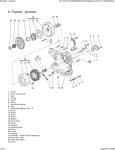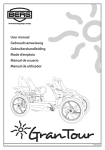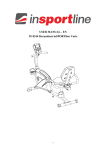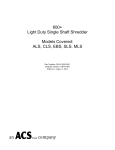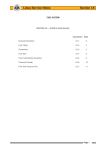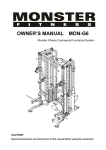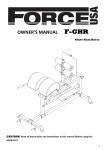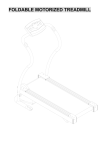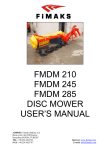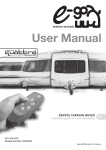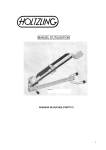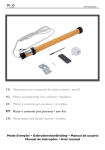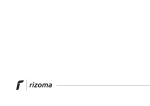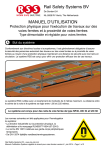Download CLUTCH - Beddysblog.com
Transcript
Lotus Service Notes Section QH CLUTCH SECTION QH Sub-Section Page General Description QH.1 3 Clutch Pedal QH.2 3 Hydraulic Release System QH.3 3 Clutch Assembly QH.4 6 Page 1 Page 2 Pipe adaptor Master cylinder GENERAL LAYOUT Steel pipe Steel pipe Bleed nipple Friction plate Hose abutment brackets Slave cylinder pl4701mt Flexible hose Fork gaiter Release fork Bearing retaining spring Release bearing Clutch cover Lotus Service Notes Section QH Lotus Service Notes Section QH QH.1 - GENERAL DESCRIPTION The driving element of the clutch assembly consists of the rear face of the engine flywheel, and a pressure plate fixed to the flywheel via the spring diaphragm clutch cover assembly. The driven element, is a single, dry, double sided friction plate, splined to the gearbox input shaft, and interposed between the flywheel and pressure plate. The diaphragm spring in the clutch cover clamps the friction plate between the pressure plate and flywheel to provide the drive connection between engine and gearbox. The gearbox input shaft, on which the friction plate is free to slide axially, is 'overhung' from the gearbox, with no spigot bearing in the rear end of the crankshaft. The hydraulic clutch release mechanism uses a master cylinder fixed to the pedal box, and a slave cylinder bolted directly to the transmission case. The master cylinder is connected to the fluid reservoir of the brake master cylinder, and uses a steel pipe routed along the outside of the LH chassis side rail to connect with the slave cylinder via a flexible hose. The slave cylinder operates a release fork which pivots on a ball end fulcrum pin and presses the release bearing against the inner ends of the diaphragm spring fingers, which pivot about their fulcrums and relieve the clamping force applied to the pressure plate via the diaphragm outer edge. The release bearing slides on a guide sleeve surrounding the gearbox input shaft. A preload spring inside the slave cylinder applies light pressure to the release lever in order to ensure that contact between the release bearing and diaphragm spring fingers is maintained. No routine adjustment of the clutch or release mechanism is required. The clutch slave cylinder is self adjusting, with the 'rest' position of the piston dependent on the thickness, or degree of wear, of the friction plate. As wear of the friction plate takes place, and its thickness is reduced, the slave cylinder piston is pushed progressively further back on the return stroke with fluid being returned to the master cylinder reservoir. QH.2 - CLUTCH PEDAL The clutch pedal is machined from an aluminium alloy extrusion which is common to the brake and throttle pedals, with an extruded footpad keyed, bonded and rivetted to the bottom of the pedal. Synthetic 'top hat' bushes are used to provide maintenance free articulation on the steel pivot shaft, with a pair of synthetic bearing rings supporting a cylindrical steel trunnion to actuate the master cylinder pushrod. Note that the two synthetic bearing rings may be replaced with the pedal 'in-situ', by using a suitable bolt with clamp washers to press the rings into position. Each bush has an outer diameter chamfer at one end to aid insertion. The master cylinder pushrod is captive in the end of the master cylinder and is screwed fully into the pedal trunnion. With the clutch pedal released, there should be a clearance between the pedal and the pedal box in order to allow the master cylinder to 'top out'. Conversely, the pedal should contact the floor before the cylinder 'bottoms out'. QH.3 - HYDRAULIC RELEASE SYSTEM Master Cylinder The clutch master cylinder is mounted on the pedal box, and is accessible from within the front services compartment. The cylinder is not equipped with its own fluid reservoir, but instead is linked via hose to the adjacent brake fluid reservoir. There is no provision for any servicing of the master cylinder, and if found to be faulty, the unit should be replaced. To replace the master cylinder: Clean the master cylinder and surrounding area with methylated spirit. Do not use petrol or paraffin. Take all necessary precautions to guard against contamination of painted surfaces with brake fluid. Disconnect and immediately plug and cap the hose connection to the fluid reservoir, and the output pipe connection. From inside the footwell, remove the two bolts securing the cylinder to the pedal box. Withdraw the cylinder from the front services compartment. To refit, reverse the removal procedure, taking care to feed the pedal pushrod through the dust boot and into the end of the master cylinder as the cylinder is positioned. Tighten the outlet pipe connection to 20 - 24 Nm and bleed the hydraulic system of air. Page 3 Lotus Service Notes Section QH Pedal box Connection to fluid reservoir Clutch master cylinder Mounting bolt Pedal pushrod Clutch pipe connector q51 Slave Cylinder The slave cylinder is secured by two bolts directly to the clutch housing on the forward side of the unit, and operates the clutch fork by a fixed length pushrod. A bleed nipple is provided by which to bleed air from the hydraulic system. Mounting bolts Slave cylinder Clutch fork Bleed nipple Steel pipe Hose connection q52 Page 4 Lotus Service Notes Section QH To replace the slave cylinder: Clean the slave cylinder and surrounding area with methylated spirit. Do not use petrol or paraffin. Take all necessary precautions to guard against contamination of painted surfaces with brake fluid. Unscrew the pipe union nut from the slave cylinder and drain the hydraulic fluid into a suitable container. Cap both pipe and cylinder port to limit fluid loss and prevent dirt ingress. Remove the two cylinder retaining bolts and withdraw the cylinder and pushrod assembly. Remove the cylinder boot and pushrod. Tap the cylinder or use a low pressure airline to remove the piston and spring from the cylinder. CAUTION - Use a workshop towel to protect against hydraulic fluid spray, and protect painted surfaces from contamination. Thoroughly clean the cylinder bore using hydraulic fluid. If any scoring, corrosion, damage or wear is evident, the cylinder assembly should be renewed. When refitting the piston and spring, use Lithium soap based glycol grease on the piston and seal before carefully inserting the spring and piston into the cylinder. Fit the pushrod into the boot and the boot to the cylinder. Fit the cylinder with the tie wrap bracket to the clutch housing, and torque the two fixing bolts to 12 Nm. Fit the hydraulic pipe to the slave cylinder and torque to 15 Nm. Bleed the hydraulic system and tighten the bleed nipple to 8.4 Nm. Bleed nipple Slave cylinder Spring Piston Pushrod Boot Fixing bolts Tie wrap bracket q53 Hydraulic Pipe A rigid steel pipe is used to convey the hydraulic fluid from the master cylinder to the left hand front corner of the engine bay. The pipe is routed through the dash baffle panel and down the LH 'A' post to run along the outside of the chassis LH main siderail, within the composite sill member, clipped to the heater pipe. The pipe terminates at a bracket rivetted to the rear end of the chassis siderail, where it connects to a flexible hose secured at its other end to a bracket on the clutch housing. A short steel pipe links this joint to the clutch slave cylinder, which uses a 'quickfit' push-in connector to aid production line assembly. Page 5 Lotus Service Notes Section QH Clutch master cylinder Dash baffle panel Steel pipe Slave cylinder Steel pipe clipped to heater pipe q46a Flexible hose to engine QH.4 - CLUTCH ASSEMBLY The clutch assembly comprises the friction plate, clutch cover assembly (pressure plate/diaphragm spring/ cover) and release bearing. For access to the clutch assembly, the engine and transmission must be separated. Removal of clutch assembly: The transmission may be removed from below: 1. Remove the LH rear suspension assembly (refer to sub-section DH.3), both driveshaft assemblies (refer to sub-section FJ.4) and the exhaust system. 2. Disconnect the clutch release fork, gearchange cables, earth braid and reverse light switch. 3. The engine must be supported to allow the engine and transmission mountings to be disconnected and the power unit tilted as necessary to allow the transmission to be withdrawn. The clutch bell housing is secured to the engine by 8 bolts as shown overleaf. 4. Matchmark the clutch cover to the flywheel before progressively loosening each clutch cover bolt half a turn at a time until clutch cover spring pressure is released. Withdraw the cover from the flywheel dowels taking care not to allow the friction plate to drop. 5. Pull the release fork off the fork pivot ball, and withdraw fork and release bearing from the transmission. Inspection 1. Clutch cover: Check the surface of the pressure plate for scoring or discolouration through overheating. Check the fingers of the diaphragm spring for excessive wear at the release bearing contact surface. If any fingers are indented to a width greater than 6mm, or a depth of 0.5mm, the cover assembly should be renewed. If the cover is accidentally dropped, the setting or balance of the assembly could be disturbed. Replacement of the cover is recommended. Page 6 Lotus Service Notes Section QH 2. Friction plate: Check the cush drive springs for breakage or cracking of the hub. Examine the condition of the friction material for signs of oil contamination, scorching, or any other damage. Using vernier callipers, measure the depth of the rivet heads below the surface of the friction material. Minimum depth: 0.3mm. With the friction plate mounted on its splines, check the run-out at the outer edge of the friction surface. Maximum run-out: 0.8mm. If addressing symptoms of clutch judder, or if any of the above inspections are not passed, renew the friction plate. 3. Release bearing: Check the bearing for discernible play, noise or rough feeling, and renew if there is any doubt. 4. Flywheel: Using a dial test indicator, measure the axial run-out at the outer edge of the flywheel drive surface. Maximum runout: 0.1mm. If necessary, renew the flywheel. When fitting the flywheel: - progressively tighten the eight fixing bolts in a diametrically opposite sequence, to 49 Nm. - mark the angular position of each bolt head, and further tighten each bolt in a diagonally opposite sequence an additional 90°. Refitting clutch assembly 1. Using a universal type centralising mandrel, position the friction plate with the 'flatter' side towards the flywheel, and fit the clutch cover onto the flywheel dowels with the match marks aligned (if applicable). 2. Fit the clutch cover retaining bolts finger tight and monitor friction plate centralisation as the bolts are progressively tightened in a diagonally opposite sequence to 19 Nm. 3. Using a dial test indicator, measure the diaphragm spring tip height variation. Maximum variation: 0.5mm. If necessary, use a special clutch tool to achieve the specification. 4. If the release fork pivot ball had been removed, refit and tighten to 37 Nm. 5. Apply sparing quantities of Molybdenum Disulphide (MoS2) grease to the contact points of the release fork fingers, release fork pivot, fork retaining spring and pushrod socket. Also apply sparingly to the transmission input shaft splines. 6. Fit the release bearing and fork together, and position in the clutch housing with the fork retained on the pivot ball by its retaining spring. Fit the dust boot into the housing aperture. 7. Refit the engine to the transmission in reverse order to removal, tightening the clutch housing bolts as follows: M12 x2; Upper 64 Nm M10 x2; RH side 37 Nm M10 x2; Starter Motor 37Nm M10 x2; Sump 23 Nm Illustration overleaf. Page 7 Lotus Service Notes Section QH Clutch housing to engine fixings - viewed from gearbox side M12x55 flange head bolts to block; 64 Nm M10x65 bolts also secure starter motor; 37 Nm M10x55 bolts to block; 37 Nm f134 M10x30 bolts to sump; 23 Nm Page 8










